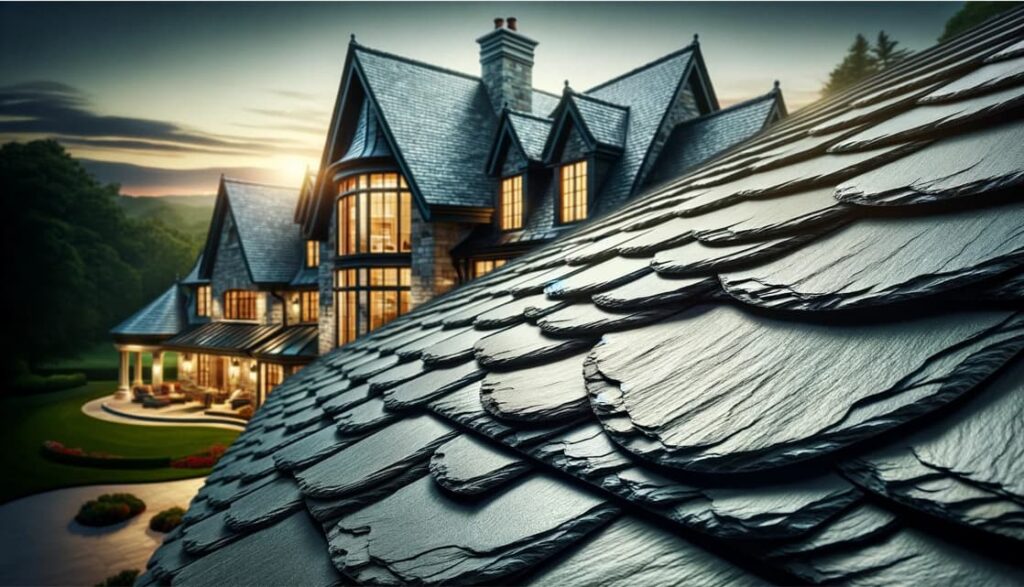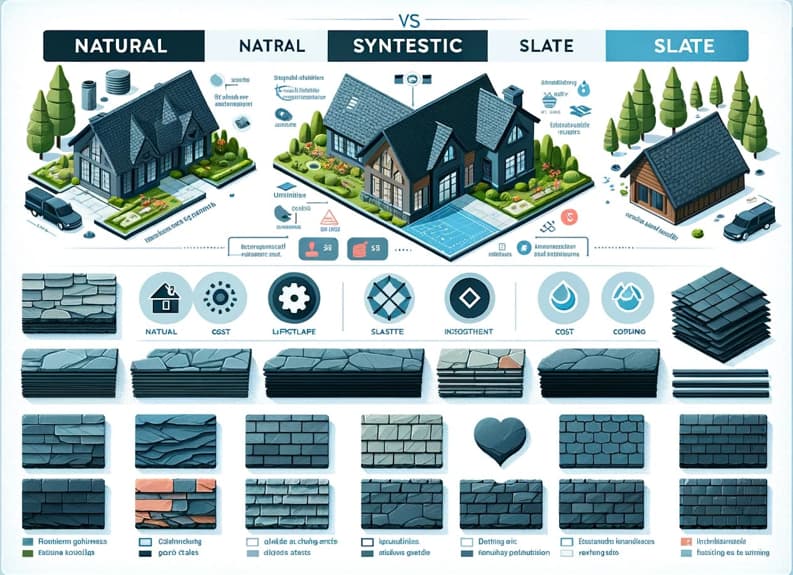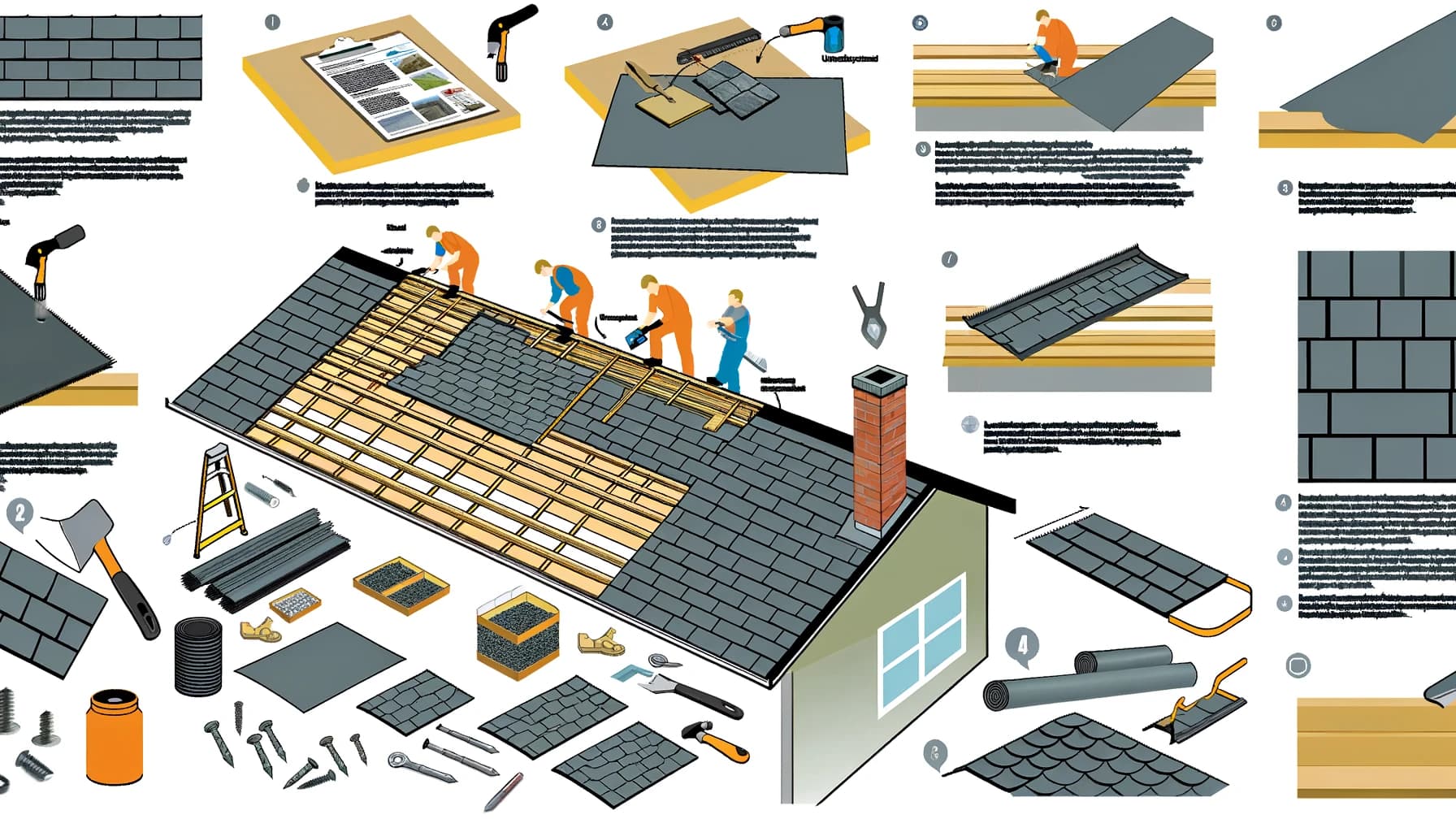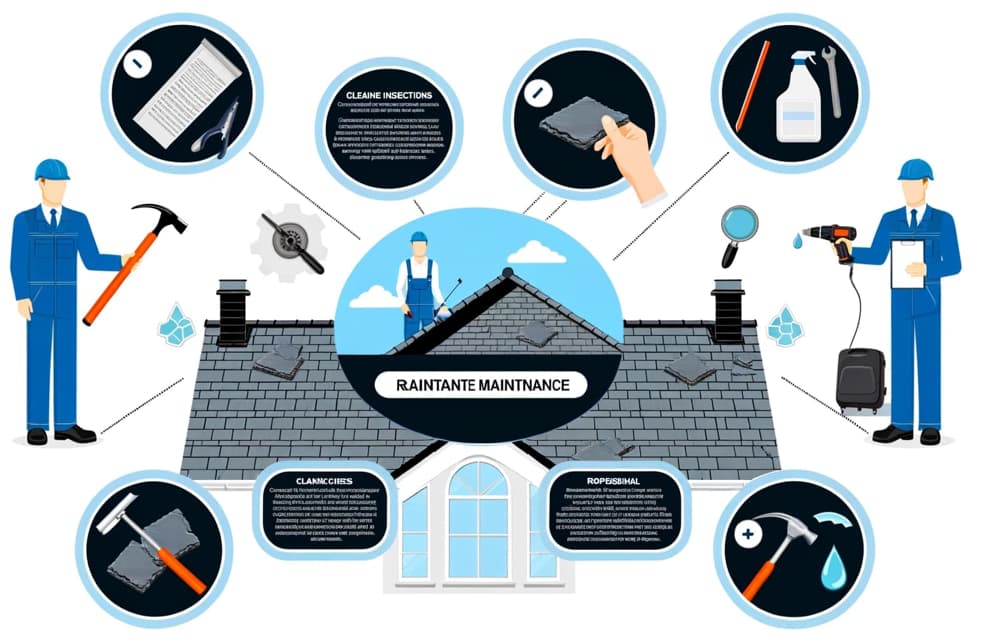Roofing
Slate Roofing Elegance Unlocked: A Comprehensive Guide
Slate roofing, with its unparalleled blend of aesthetic appeal and unmatched durability, represents the zenith of roofing materials. This comprehensive guide aims to equip you with everything you need to know about slate roofing, ensuring you make an informed decision for your home.
1. Introduction to Slate Roofing
When it comes to selecting a roofing material that combines enduring strength with timeless beauty, few options can match the elegance and resilience of slate roofing.
Slate, a natural stone quarried from the earth, has been cherished for centuries for its remarkable durability and unique aesthetic appeal.
This section delves into the characteristics that make slate roofing a prestigious choice for homeowners seeking a blend of luxury, longevity, and natural charm.
The Essence of Slate Roofing
Slate roofing is more than just a protective covering for your home; it is a statement of style and a commitment to quality.
Crafted from natural slate tiles, this roofing option stands in a class of its own, offering an unparalleled level of sophistication and structural integrity.
Each slate tile is a slice of geological history, bringing with it a unique texture, color, and durability that synthetic materials struggle to replicate.
Unmatched Durability
One of the hallmarks of slate roofing is its incredible durability. Slate is nearly impermeable, making it highly resistant to water absorption, frost damage, and harsh weather conditions.
Its resilience against environmental wear and tear means that a well-installed slate roof can protect your home for decades, if not centuries, without succumbing to decay.
Aesthetic Appeal
Slate roofs are renowned for their aesthetic appeal. The natural variation in color and texture of slate tiles ensures that no two roofs are exactly alike, offering a range of hues from deep greys and earthy greens to vibrant blues and purples.
This natural beauty enhances the architectural design of any home, from historic renovations to modern constructions, providing a look of sophistication and elegance that is unmatched by other roofing materials.
Environmental and Safety Benefits
Choosing slate roofing is also a nod to environmental sustainability and safety. Slate is a natural, recyclable material that does not emit harmful toxins during its lifecycle.
Additionally, its fire-resistant properties offer an extra layer of protection for your home, making it a safe choice for roofing material.
The Journey from Quarry to Roof
The journey of slate from quarry to roof is a testament to the material’s authenticity and natural origin. Mined from deep within the earth, slate is carefully selected, cut, and shaped into durable tiles ready for installation.
This process, while labor-intensive, ensures that each slate tile meets high standards of quality and beauty, ready to withstand the test of time atop your home.
Ready to elevate your home with the timeless beauty of slate roofing? Learn more about your options.
2. The Historical Significance of Slate Roofing
The storied past of slate roofing is as layered and enduring as the material itself. Originating in the misty regions of North Wales around the 1300s, slate has been a symbol of architectural prestige and durability for centuries.
Its journey from the rugged landscapes of early Europe to the sophisticated roofs of modern homes across the world is a testament to slate’s unmatched qualities and the historical significance it holds in roofing tradition.
In the United States, the slate roofing industry marked its beginning in the early 18th century, with the first quarry opening on the border between Pennsylvania and Maryland in 1734.
This event heralded a new era for slate roofing in America, bringing the luxury and resilience of this material to the New World.
As slate quarrying expanded in Vermont, New York, Pennsylvania, and Virginia, it shifted from a material for castles to a favorite for homes, gaining appeal in the 1800s due to its longevity and aesthetic range despite its cost.
Available in a myriad of natural colors, from somber greys and greens to vibrant purples and blues, slate roofs could complement any architectural style, enhancing the beauty and value of any property.
Moreover, the material’s ability to withstand decades, if not centuries, of exposure to the elements without decay, made it a sensible, albeit prestigious, investment for homeowners.
Discover the rich history that makes slate roofing a prestigious choice. Dive deeper into the past.
Today, the legacy of slate roofing continues to inspire admiration and respect. As both a nod to architectural heritage and a choice for future sustainability, slate roofing embodies the perfect blend of history, beauty, and enduring strength.
Its historical significance not only enriches the aesthetic of homes but also serves as a reminder of the timeless quality and craftsmanship inherent in traditional roofing materials.
3. Understanding Slate Roofing
When considering a roofing material that stands the test of time while elevating the aesthetic appeal of your home, slate roofing emerges as a superior choice.
This section provides a detailed look at the distinct characteristics of both natural and synthetic slate roofing, alongside a comparative analysis to aid in making an informed decision.
Natural vs. Synthetic Slate Roofing
Slate roofing is predominantly available in two forms: natural and synthetic. Natural slate, a metamorphic rock formed over centuries, offers unparalleled beauty and longevity.
Synthetic slate, on the other hand, is a composite material designed to mimic the appearance of natural slate but with additional benefits related to cost and installation.
Pros of Slate Roofing
- Aesthetic Appeal: Both natural and synthetic slates offer a beautiful, timeless look.
- Longevity: Natural slate roofs can last from 50 to 200 years, while synthetic slate also offers considerable durability.
- Fire Resistance and Insect Proof: Slate’s composition makes it naturally resistant to fire and pests.
- Eco-Friendly: Slate is recyclable and environmentally friendly, with natural slate having minimal processing and synthetic options often made from recycled materials.
Cons of Slate Roofing
- High Cost: The initial investment for natural slate can be significant, though synthetic options are more affordable.
- Weight: Natural slate is heavy, potentially requiring structural modifications to support the weight.
- Installation Complexity: Both types require skilled installation, but synthetic slate is generally easier to work with.
Comparative Analysis: Natural vs. Synthetic Slate
To better visualize the differences between natural and synthetic slate, consider the following table:
| Feature | Natural Slate | Synthetic Slate |
| Material | Metamorphic rock | Composite materials |
| Lifespan | 50-200 years | 30-50 years |
| Weight | Heavy (675-1870 lbs per 100 sq. ft.) | Lighter than natural slate |
| Cost | High ($1000-$2500 per square) | More affordable than natural |
| Installation | Requires specialized skills | Easier, can be handled by regular roofers |
| Environmental | Minimal processing, recyclable | Often made from recycled materials |
| Aesthetic | Unique color and texture variations | Mimics natural slate, various colors |
| Fire Resistance | High | High, depending on materials used |
| Maintenance | Low but specific | Generally low |
4. Key Considerations for Choosing Slate Roofing
Selecting the right slate roofing involves more than just appreciating its aesthetic appeal and durability.
Homeowners must carefully evaluate several critical factors to ensure that their investment not only enhances the beauty of their homes but also meets practical requirements and budgetary constraints.
Structural Integrity and Weight
The substantial weight of natural slate roofing necessitates a thorough assessment of your home’s structural integrity.
Not all buildings are designed to support the weight of a slate roof without additional reinforcement.
Before installation, consulting with a structural engineer can determine whether your home requires retrofitting, a process that can significantly impact overall costs.
Budget Considerations
Slate roofing, particularly natural slate, is among the most expensive roofing materials on the market. The cost includes not only the materials themselves but also the specialized labor required for installation.
Synthetic slate offers a more budget-friendly alternative, providing the look of natural slate at a fraction of the cost. It’s essential to balance your desire for a slate roof with the realities of your financial situation.
Finding Skilled Contractors
The installation of a slate roof is a specialized skill, underscoring the importance of selecting a contractor with specific experience in slate roofing.
Proper installation is critical to the roof’s longevity, appearance, and performance.
When considering a contractor, evaluate their track record, ask for references, and ensure they have specific training in handling both natural and synthetic slate materials.
Ensure your home is ready for slate roofing. Get a professional evaluation.
5. Types of Slate Roofing
Exploring the types of slate roofing available allows homeowners to make informed decisions based on aesthetics, durability, and cost.
Natural Slate Roof Options
Natural slate is renowned for its beauty and lifespan, which can extend up to 200 years.
It comes in various colors and textures, influenced by the slate’s mineral composition and the region from which it is quarried.
The choice between hard (more durable) and soft (less durable) slate can affect both the roof’s longevity and price.
Synthetic Slate Alternatives
Technological advancements have led to the development of synthetic slate roofing materials, which replicate the look of natural slate with benefits such as reduced weight and cost.
These materials typically comprise rubber, plastic, or a blend of composite materials, offering improved installation ease and a wider range of color options than their natural counterparts.
6: Slate Roof Installation
The installation process for slate roofing is intricate and demands a high level of expertise to ensure that the roof functions correctly and maintains its aesthetic appeal over time.
Preparation and Underlayment
Installation begins with preparing the roof deck, which must be strong enough to support the weight of the slate. A high-quality underlayment is essential to protect against water infiltration, particularly for natural slate roofs.
Tile Layout and Installation Techniques
Whether working with natural or synthetic slate, the layout pattern significantly impacts the roof’s appearance.
Options include random-width patterns, which offer a more traditional, rustic look, or uniform patterns that provide a cleaner, more modern appearance.
Each tile must be carefully placed and secured to prevent leaks and ensure longevity.
Flashing and Finishing Touches
Proper flashing around chimneys, vents, and roof valleys is critical to prevent water damage. The selection of flashing materials and the precision of installation work together to protect the home from water intrusion.
Contractor Selection
Given the complexity of slate roof installation, choosing the right contractor is crucial. The contractor should have a proven track record with slate roofing, offering both expertise and a solid workmanship warranty.
Trust only the best with your slate roof installation. Contact experienced installers today.
7. Maintenance and Care for Slate Roofs
Maintaining the integrity and beauty of a slate roof requires a nuanced approach that respects the material’s natural properties while safeguarding its longevity.
Although both natural and synthetic slate roofing systems are celebrated for their durability, regular maintenance ensures they continue to protect and enhance your home effectively.
Regular Inspections
Annual or biannual inspections are crucial for identifying potential issues before they escalate.
These inspections should focus on assessing the slate tiles for any signs of damage, such as cracking, chipping, or shifting, which could compromise the roof’s integrity.
Attention should also be given to the flashing around chimneys, valleys, and along the roof edges, as these areas are prone to leaks.
Cleaning and Debris Removal
Slate roofs should be kept free of debris, such as leaves, twigs, and dirt, which can accumulate and retain moisture.
This moisture retention can lead to moss and algae growth, particularly on natural slate, which may not only affect the roof’s appearance but also its functionality by trapping moisture against the surface.
Gentle cleaning methods should be employed to avoid damaging the slate.
Repairing Damaged Tiles
One of the benefits of slate roofing is the ability to replace individual tiles that have been damaged without needing to disturb the entire roof.
It’s essential, however, that repairs are carried out by professionals experienced in working with slate. Due to the material’s brittleness, improper handling can lead to further damage.
Synthetic slate tiles also benefit from individual replacement, offering a practical advantage in maintenance and repair scenarios.
Professional Maintenance
Given the specific expertise required to properly care for and maintain a slate roof, engaging professional roofing contractors who specialize in slate is advisable.
These professionals can conduct thorough inspections, perform necessary repairs with the correct tools and techniques, and provide guidance on keeping your slate roof in optimal condition.
Keep your slate roof in top condition. Learn about our maintenance services
Preventative Measures
Preventive maintenance, such as ensuring gutters and downspouts are clean and functional, can greatly extend the life of a slate roof.
Proper water management prevents overflow and water accumulation, which could otherwise seep under the slate tiles and into the roof deck.
Weather and Environmental Considerations
In regions prone to severe weather, additional precautions may be necessary to protect a slate roof from storm damage.
Regular checks following heavy storms or freezing conditions can help catch and address any damage early, preserving the roof’s structural integrity.
A table for maintenance and care tips for slate roofs
| Maintenance Task | Frequency | Natural Slate | Synthetic Slate | Notes |
| Inspection for Damage | Biannually | ✓ | ✓ | Check for cracked, chipped, or missing tiles, especially after severe weather events. |
| Cleaning and Debris Removal | Annually | ✓ | ✓ | Remove leaves, twigs, and other debris. Address moss or algae growth as needed. |
| Gutter and Downspout Cleaning | Biannually | ✓ | ✓ | Ensure proper water flow away from the roof to prevent water damage. |
| Repairing or Replacing Tiles | As needed | ✓ | ✓ | Damaged tiles should be replaced promptly to avoid leaks. |
| Flashing Inspection | Annually | ✓ | ✓ | Check flashing around chimneys, valleys, and edges for signs of wear or leaks. |
| Professional Roof Check | Every 3-5 years | ✓ | ✓ | Detailed inspection and maintenance by a professional experienced in slate roofing. |
It’s a useful tool for planning and can help prevent minor issues from becoming major problems.
8. Cost Analysis of Slate Roofing
While the upfront cost of slate roofing is high, its long-term value is unmatched. Careful budgeting and consideration of both natural and synthetic options will help balance your desires with financial realities.
9. Selecting the Right Slate Roof for Your Home
Choosing the perfect slate roof involves more than just selecting a color. Matching the roofing material to your home’s architectural style is crucial for achieving a harmonious look. Consult a roofing expert to find the ideal slate for your residence.
10. Slate Roofing: The Pros’ and Cons’ Summary
When considering slate roofing for your home, weighing the advantages and disadvantages is crucial for making an informed decision.
Slate roofing, with its natural beauty and longevity, presents a compelling option for many homeowners.
However, it’s essential to consider all aspects, from cost to maintenance, before proceeding. Here’s a detailed overview encapsulated in an easy-to-digest table format.
Considering slate roofing? Review the pros and cons to make an informed decision
Summary Table: Pros and Cons of Slate Roofing
| Pros | Cons |
| Aesthetic Appeal | High Cost |
| Slate roofs offer unparalleled beauty and elegance, enhancing the architectural appeal of any home. | Initial investment and installation costs are higher than most other roofing materials. |
| Longevity | Weight |
| With lifespans of up to 200 years for natural slate, these roofs are a once-in-a-lifetime investment. | The heavy weight of slate requires a strong structural support, which might not be present in all homes. |
| Fire Resistance | Special Installation |
| Slate is naturally fire-resistant, offering added safety to homes. | Installation requires specialized skills and experience, limiting the choice of contractors. |
| Eco-Friendly | Maintenance |
| Being a natural material, slate is recyclable and has minimal environmental impact. | While generally low, maintenance must be performed by experienced professionals to avoid damage. |
| Insect Proof | Brittleness |
| Slate roofs are resistant to insect infestations, protecting the structural integrity. | Despite its durability, slate can be brittle and prone to breaking under impact. |
This table highlights the key factors to consider when contemplating a slate roof for your home. While the pros of aesthetic appeal, longevity, fire resistance, environmental friendliness, and being insect-proof make slate an attractive choice.
it’s also important to account for the cons, including the high initial cost, weight, complexity of installation, brittleness, and specific maintenance requirements.
11. Installation Challenges and Solutions
Slate roof installation presents unique challenges that require specialized knowledge and techniques to overcome.
The beauty and longevity of a slate roof are contingent upon flawless installation, making it imperative to address these challenges head-on.
Challenges in Slate Roof Installation
- Weight Management: The significant weight of slate tiles necessitates a robust support structure. Without proper reinforcement, the integrity of the building can be compromised.
- Skill Requirement: The installation of a slate roof demands precision and expertise. Each tile must be correctly aligned and secured to ensure the roof’s aesthetic appeal and functional performance.
- Brittleness Handling: Slate’s brittleness requires careful handling during transportation and installation to prevent chipping and breakage.
- Customization Needs: Each slate tile is unique, necessitating custom fitting and trimming to achieve a harmonious roof appearance. This process can be time-consuming and requires meticulous attention to detail.
Solutions to Overcome Installation Challenges
- Structural Assessment and Reinforcement: Engaging a structural engineer to assess and, if necessary, reinforce the building’s structure is a critical first step.
- Hiring Specialized Contractors: Only contractors with specific experience in slate roofing should be employed, ensuring they possess the requisite skills and knowledge.
- Pre-installation Planning: Detailed planning, including the layout and ordering of extra materials to account for potential breakage, can mitigate installation risks.
- Utilizing Modern Tools and Techniques: Advanced cutting tools and installation methods can enhance efficiency, reduce waste, and ensure the integrity of each slate tile.
Facing installation challenges? See how we overcome them.
12. Slate Roofing Warranty and Insurance Considerations
Given the natural composition of slate, warranties primarily cover workmanship. Ensuring your contractor offers a robust warranty is critical for protecting your investment.
Protect your investment with the right warranty. Understand your warranty options.
13. Innovations in Slate Roofing
The roofing industry continues to evolve, with innovations in synthetic slate offering homeowners more choices than ever. These advancements promise to extend the appeal of slate roofing to a broader audience.
Stay ahead with the latest in slate roofing. Check out new innovations.
Conclusion
Slate roofing stands as a testament to both the artistic and functional aspirations of homeowners.
Whether you choose natural or synthetic slate, the decision to invest in a slate roof is a commitment to quality, durability, and timeless beauty.
As you contemplate the best roofing material for your home, remember, a slate roof isn’t just a choice; it’s an investment in the future of your home.
Are you ready to embrace the enduring elegance of slate roofing for your architectural masterpiece?
Recent Posts
- Wood Roofing Guide: Elegance & Durability
- Flat Roof – Decoding: Installation, Maintenance, and Materials
- Black Metal Roofing : The Comprehensive Guide
- What Are the Best Roofing Shingles for Your Home?






